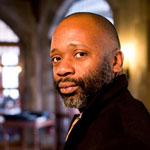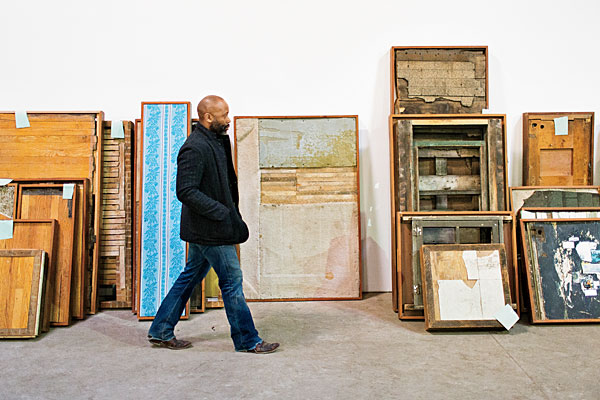
On a warm Sunday evening, Theaster Gates is weaving around a room he designed and stocked with history books, leather-bound volumes of Ebony and Jet magazines, and pottery he made. He moves with more of a hop than a walk, his well-worn cowboy boots scuffing the wood floor. He calls out mournfully, “I know I’m on this tedious journey. . . . Walk with me, O Lord, walk with me.”
His cries are echoed by a young female vocalist, a spoken-word poet, and five musicians—on cello, bass, percussion, and keyboards—who surround him. Together, their haunting, anachronistic sound evokes African American spirituals, the blues of B. B. King, even the experimental jazz of Sun Ra.
This is an April rehearsal for Gates’s first major solo exhibition in his native Chicago, which is to open in a few weeks at the Museum of Contemporary Art. (The show runs from May 18 to October 6.) The music provides a sharp contrast to the noises just outsidethe room’s open windows: the backfiring mufflers, blasting boom boxes, and chatting passersby that are shepherding his troubled South Side neighborhood of Grand Crossing into spring.
Without hesitation or explanation, Gates shifts gears, beginning to beat his leg to signal a faster tempo. “Will you take a drive, a drive with me?” he sings, and the band follows. “Take a drive with me in my Model T?”
The sounds grow more and more reckless until the keyboardist, Michael Drayton, who directs music every Sunday at St. Sabina, the influential South Side church, interrupts. “What exactly are we doing?” he asks.
Gates hikes his knee up onto a stool. “It’s a jumbled mess,” he says, with a face that’s half earnest, half shit-eating mischief. “I hope, at best, it’s complicated to understand what I’m trying to get across.”
Complicated? Absolutely. And it’s precisely his embrace of complications that has helped vault Gates, 39, from humble beginnings on the West Side to the center of the international art world. He held his first solo show, at the Hyde Park Art Center, just six years ago; last year ArtReview put him at No. 56 on its annual list of the 100 most powerful people in the business. (He’s below British star Damien Hirst and heavyweight gallerist Larry Gagosian but ahead of celebrated artists Jeff Koons and Steve McQueen, not to mention Miuccia Prada, the designer and arts patron.)
It’s even complicated to describe exactly what kind of artist Gates is. Trained as a potter and educated as an urban planner, he’s a craftsman with a well-honed visual aesthetic, a sensual performer whose harmonies can give you goose bumps, and a critical thinker who uses art to raise provocative questions about race. “He’s a sculptor, an installation artist, a performance artist,” explains his old friend Hamza Walker, an associate curator at the Renaissance Society. “He’s nine things at once.”
Above all, Gates is an enterprising, charismatic operator in a city teeming with operators—a guy who has figured out how to profit from the art world’s need to latch on to something with meaning. He’s also successfully spinning activist art into serious cash: Some of his pieces now command upwards of $100,000.
At the same time, Gates holds a respected post as an arts administrator at the University of Chicago and is bent on helping the school break out of its ivory tower and improve its relationship with its less affluent neighbors on the South and West Sides. [Editor’s note: Elly Fishman, who cowrote this story, worked for him part-time in 2010 and 2011.] And in his own neighborhood of Grand Crossing, he has an ambitious plan to convert a swath of dilapidated old buildings into creative playgrounds, with potentially major implications for the future of the most desperate neighborhoods in Chicago and beyond.
While Gates is not without his critics, his urban vision is why so many influential people appear to have fallen under his spell. “There are philanthropists who are art collectors who are his greatest fans,” says the Chicago gallerist Kavi Gupta, who represents Gates. “After people come down to Dorchester”—a group of Grand Crossing buildings that Gates bought, rehabbed, and transformed into artists’ spaces, archives, and a movie house devoted to screening African American films—“they line up and say, ‘What can we do for you?’ ”
On a block full of empty lots, foreclosed houses, and boarded-up windows, Gates has become the biggest property owner (see the map on page 3). That fact comes with its own set of artistic opportunities and social responsibilities. “The stakes are very high,” he acknowledges. “The stakes are very high.”
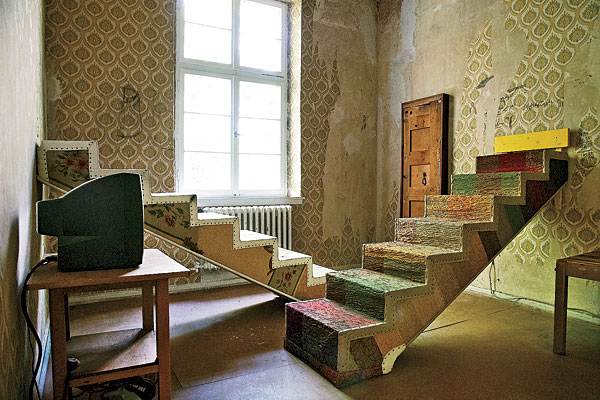
Gates knows all about troubled areas. In the 1970s, unemployment in his family’s mostly black neighborhood, East Garfield Park, ran as high as 35 percent. His father, also named Theaster, had a job as a roofer, but his income didn’t go far: He and his wife, Lorine, had nine children to feed. (Gates is the youngest and the only boy.) “There were not artists in our family,” says Gates’s nephew Titus Wonsey, 23. “No one thought about that seriously as a career path.”
But Gates says that accompanying his father on roofing jobs constituted a kind of artistic awakening. “My first experience with the creative was mopping tar,” he says, describing a skill that requires dance-like movements. “If you let the tar sit, it can get cold pretty quickly. And because the mops are so heavy, you’ve got to dip it and then ride it really fast,” Gates explains as he moves an imaginary mop across the floor. He starts clapping and pounding his feet, lost in the memory.
If rooftops are where Gates learned to use his hands, church is where he became a performer. His family attended New Cedar Grove Missionary Baptist Church every Sunday. At age 13, the youngster became the church’s youth choir director. “It was the late 1980s, when community choirs were very popular in Chicago,” he recalls. “We looked up to the Thompson Community Singers [a Grammy-winning South Side gospel choir]; they were musical and style heroes. Instead of Vogue magazine, you had the church musical. It was like, Oh, I want a fade like that.”
In the fifth grade, he and a few other promising kids from his neighborhood school were invited to attend Reilly Elementary on the Northwest Side. Gates subsequently landed at Lane Tech, a prestigious public high school at Addison Street and Western Avenue. He took the bus there from East Garfield Park. “Every day you get past North and Armitage, and you start to look different,” he says. “I have walked two worlds since fifth grade. I had a better understanding of both because I was moving between them.”
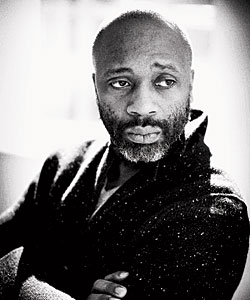
After graduating from Lane Tech—where his social circle included drama geeks and members of the French club—he headed to Iowa State University to study urban planning. In his junior year, he took a pottery class. “It went pretty well,” says Gates, “and I took another one.”
His interest in pottery, and in the arts in general, quickly grew. Toying with the idea of pursuing sculpture full-time, he succumbed to 20-something wanderlust for the next few years, at one point studying traditional African religions at the University of Cape Town. In 1999, he won a ceramics residency in Tokoname, Japan, where he worked with a group of master potters for four months. It was a seminal experience. “[Potters] were craftsmen in the United States, but in Japan, they were artists,” he says.
Gates returned to the States and soon landed a job as the Chicago Transit Authority’s arts planner, charged with arranging murals and art along the train lines. Craving more influence, he quit five years later and returned to Iowa State to pursue a multidisciplinary master’s degree in urban planning, religion, and sculpture. “When he resigned from his CTA position, which was a good job with benefits, a lot of the family was like, ‘Whoa, what is he doing?’ ” says Wonsey.
After his 2006 graduation, Gates was hired as an artist in residence and guest lecturer at the University of Chicago. (He’s now in charge of the university’s Arts and Public Life program.) In his spare time, he continued to make pottery and participate in group shows. The varied experiences of his 20s fed his art, Gates says: “Things accumulate, and then they expedite your life in ways you don’t imagine.”
In 2007, he landed a small solo exhibition, Plate Convergences, at the Hyde Park Art Center. The show revolved around the fictional story of a Japanese potter who moved to Mississippi—a twist on his own family history (the Gateses had moved to Chicago from Mississippi). It was part exhibit, part happening: Gates made a series of Japanese-style ceramics on which he served what he called Japanese soul food (black-eyed pea sushi, a mash of sweet potatoes and sticky rice) in a carefully curated dinner party.
It’s a format he would end up relying on time and again as a way to draw other artists, philanthropists, grant makers, critics, black culturati, and assorted beautiful people into his universe.
“Theaster is not your usual experience,” says Michelle Boone, Chicago’s commissioner of cultural affairs, who has known the artist since the late 1990s. “He is all about using his work to express what is happening in the culture right now.”
Gates used these evenings to cultivate a personality as a charmer, a flirt, and a master of the social spectacle. In a way, he was becoming his own best work of art: a young James Brown in a linen blazer and cowboy hat—if Brown had immersed himself in Homer, Foucault, and Jane Jacobs. He could be the captivating Soul Train conductor, the inscrutable artiste, or the bloviating armchair academic, depending on who was in his audience.
While the show generated a bit of buzz, it took almost two years for Gates to get something bigger: an emerging-artist showcase at the MCA. This time he delivered a racially charged experience that zeroed in on black American identity in a way that Plate Convergences had not. In one performance, he stood in the middle of a large room, warming his hands. “Boss!” he shouted in a pointedly servile tone, assuming the role of an overly solicitous midcentury bootblack. “I’m gonna shine some shoes!”
For that show, called Temple Exercises, Gates built a large “temple space” out of discarded wooden shelves that had been used as conveyor pallets for Wrigley’s Spearmint gum. (He got them on a tip from the South Side master recycler Ken Dunn.) He and a band he assembled, the Black Monks of Mississippi, performed there and in two other spaces: Little Black Pearl, Kenwood’s art education center, and Shine King, a legendary storefront on Chicago’s West Side.
It was a pivotal moment. Together, the spaces embodied the three public sides of Gates: the emerging contemporary art star, the neighborhood activist, and the boy from the hardscrabble West Side neighborhood. And the exhibition’s healthy attendance reinforced his instinct that great art doesn’t have to happen within a museum’s walls.
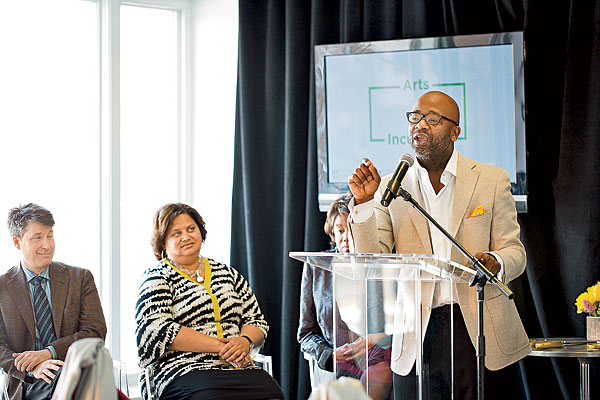
The same year that he was hired at the U. of C., Gates stepped through the doors of a boxy former candy shop that a friend was renovating in nearby Grand Crossing. It wasn’t an area where most university staffers would choose to live: For one thing, the violent crime rate there was three times that of the city as a whole. But it was close to campus and more affordable than Hyde Park—and the building featured a spacious front room where Gates could set up a studio. At $130,000, “it was not a comfortable building purchase,” he recalls. “I had to take out an ARM [adjustable rate mortgage] at 17 percent.”
Two years later, in 2008, the adjacent two-flat went up for sale. “I wanted to control the building next to me,” Gates says when describing his interest in buying it. “It had been condemned, and I could hear water running in the basement.” When he saw a realtor coming out of the building, he asked how much it cost. The answer was $16,000. He bit.
That purchase marked the unintentional start of Gates’s career as a developer. While he says that he didn’t have a specific purpose for the building in mind, he now had a space all his own where he could entertain potential investors such as Eric Whitaker, Anita Blanchard and Marty Nesbitt, and Deone Jackman, a Hyde Park art collector and an early enthusiast. “I was just incredibly impressed with what he was doing in poverty-ridden neighborhoods,” Jackman says.
That spring, Jackman gave Gates $10,000 to help rehabilitate the two-flat. Soon he was talking about hosting Japanese soul food dinners there and building up enough “cultural capital” to spur conversation about how to change troubled blocks.
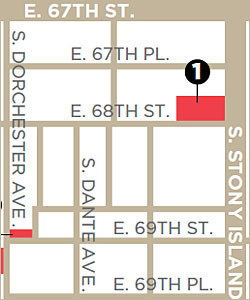
He relied on many people to help figure that out, including Dan Peterman, an installation artist and founder of Experimental Station, a community arts space in Woodlawn. Peterman was a few steps ahead of Gates in both experience and prestige, but he recognized the younger artist’s potential. “I encouraged local engagement and rootedness,” says Peterman. “In the end, it can be difficult to sustain the nomadic life of an artist. It’s important to not totally give yourself over to the art world.”
Today that two-flat, at 6916 South Dorchester Avenue, is a kind of cabinet of curiosities: a massive archive that houses 14,000 architecture books rescued when the Prairie Avenue Bookshop closed, 60,000 glass slides from the U. of C.’s art history department, and floor-to-ceiling shelves full of African American history titles such as The Slave Trade and A Mob Intent on Death.
Gates lives nearby, in the upper floor of the third building he purchased and renovated. Unmarried and childless, he has created an aesthete’s man cave: Volumes of art and history books serve as room dividers, a dual turntable pumps out Roberta Flack, a shower has been rehabbed to look like a sauna, and a pair of well-worn cowboy boots peek out from under the bed. It looks like what might happen if an urbane interior designer got locked in a Midwest barn for a week.
But Theaster Gates’s Mississippi-meets-black Chicago-meets-Apartment Therapy brand was still being sorted out in June 2009, when another influencer came calling: the internationally known curator Francesco Bonami (who for a time was a curator at large for the MCA). Bonami was organizing the 2010 Whitney Biennial—the most prestigious group contemporary arts show in the country—and wanted to check out Gates’s studio.
The artist gathered a crew and spent the next 48 hours cleaning the cobwebs and dust piles from the corners of the two-flat. He showed a video of Temple Exercises and projected an image of a Sung Dynasty porcelain vase on the wall. Like Warhol’s Factory, the house buzzed with excitement, an energy that permeates Gates’s work to this day. “It was when Francesco came [to Dorchester] that I thought, I can do things like talk about the conditions of a neighborhood by emblematically presenting this building,” Gates recalls.
Bonami wound up tapping Gates for the Biennial but didn’t give him a plum spot in the main exhibition hall. Gates was placed below it, in a courtyard next to the museum’s restaurant. Here an artist could be overlooked—or could seize the opportunity to transform a nontraditional space and capture the attention of a hungry audience lining up for $15 pork belly sandwiches while he was at it. Gates did the latter, reprising parts of Temple Exercises and staging several Black Monks of Mississippi performances under a light box that read “SHINE.”
Now the art world was starting to pay attention. “What is important about Theaster is that he is leveraging the attention that he is getting for really remarkable, and ambitious, projects,” says Peter Taub, the MCA’s director of performance programs. “With that comes opportunities to make change.”
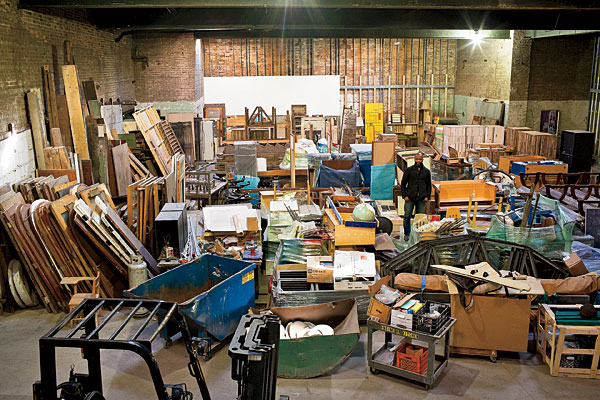
Gates’s art career can be divided into two phases: pre- and post-Whitney. Before the Biennial, he was relatively unknown beyond Chicago. Afterward, he began fielding calls from collectors, offers of high-profile artist residences and fellowships, and career-defining invitations—such as one from the curators of the 2012 Armory Show in New York City to be the year’s featured artist.
Each of Gates’s post-Whitney exhibitions was bigger and more ambitious than the one before. At the Milwaukee Art Museum, for example, he showed sculptures made from discarded Kohler sinks and invited scores of vocalists from the city’s gospel community to join him in songs inspired by the slave ceramicist-poet Dave the Potter. At the London gallery White Cube—which represents Damien Hirst, Chuck Close, and now Gates—he hung a salvaged 1967 Ford fire truck from the ceiling to reference the use of fire hoses on civil rights protesters in Birmingham, Alabama, in 1963. He did so against a backdrop of thousands of bound Ebony and Jet magazines. “What better way to support African American artists than to give them material to use in their art?” says Linda Johnson Rice, the Johnson Publishing chairman and Gates collector who greenlighted the magazine donation.
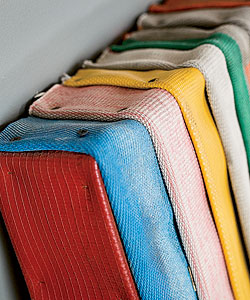
An art object (one made from old fire hoses)
But no project quite illustrates the scope of Gates’s ambition like 12 Ballads for Huguenot House, which he unveiled last summer in Kassel, Germany, at the sprawling contemporary art fair Documenta 13. Coproduced by the MCA (which got first dibs on the sequel, 13th Ballad), 12 Ballads was his biggest feat yet: a real-estate mash-up more extreme than any stunt on HGTV. It involved the teardown and partial reconstruction of an abandoned Grand Crossing house inside a hulking vacant German apartment building.
Gates says that he was inspired by the ideas of servitude, migration, and black labor. But this explanation is elliptical and, in typical Gates fashion, confusing. When asked about it recently, he said that the Kassel installation—assembled over the course of two months with about a dozen Americans and Germans who lived, worked, and partied in the house—allowed him to engineer a solution to two “big ass” forlorn buildings: one left to rot in Chicago and the other in Kassel, which had been heavily bombed by the Allies in World War II.
Tate Modern curator Mark Godfrey, writing for the magazine Frieze, said that he was moved by the intimate reality of the house and how Gates’s team repurposed everything. Even the beds in which they slept—also on display—were made from wood planks carted in from Chicago. Godfrey described Gates as “a master of testing out well-meaning white curator-critics like myself”—suggesting that Gates uses his confrontational stage persona in part to manipulate the mostly white art establishment.
That’s the closest thing to a criticism of Gates that you’ll find in the art press—or from talking to people familiar with his work. (We know; we talked to nearly two dozen.) Because he has “staked out a very broad territory,” as James Rondeau, the Art Institute’s chief curator of contemporary art, puts it, just about everyone has skin in the game when it comes to Gates’s success. No one in Chicago’s arts community wants to see his star wane: He has brought it the oxygen of international acclaim. People who have invested in the betterment of the South Side certainly don’t want to see him fail. Nor does the U. of C., which has made him the face of a crucial community outreach program in Washington Park through its new $2 million arts incubator. And, of course, the wealthy people who collect his art and the galleries that sell it to them will lose if the value of his work falls.
For 13th Ballad at the MCA, Gates has loosely planned a three-part display in the museum’s atrium, says Kate Hadley, his studio and exhibition manager. A large double cross will be suspended from two beams and feature compartments that hold souvenirs from the Documenta 13 show; an altar will be constructed of salvaged wood. Gates is also incorporating 13 discarded pews carted out of the U. of C.’s interdenominational Joseph Bond Chapel. The pews will represent a “huge big-E ecumenical experience,” says Gates.
It wouldn’t be a Gates show without performance. He and his band will appear three times, and South Side church choirs have been invited to participate. Separately, in a fourth-floor screening room, video will loop of performances from Grand Crossing and from Kassel.
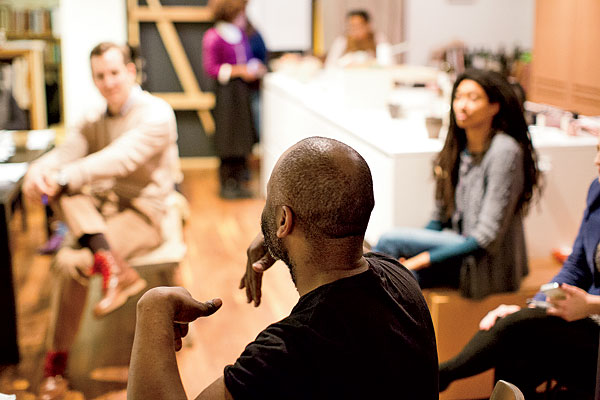
Despite his success with museum exhibitions, Gates has an uneasy history with museums—specifically with their need for objects. “It was really through the naiveté and the myopic vision of museums that I came to need to make a thing,” he says. “Even after the Whitney Biennial, [curators] were like, ‘We always enjoy talking to you, Theaster, but what are you going to show? You don’t have a lot of things.’
“I was like, ‘That’s not true. I have this house thing. I have this dinner thing. I have this singing thing. I have things.’
“But they said, ‘What is going to live in our space?’ ”
He calls such conversations “reasonable fucked-up requests.”
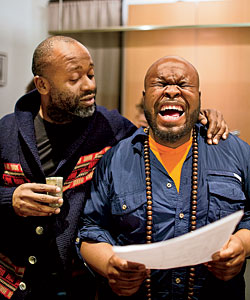
Gupta tells a story about how, before the 2009 NADA Art Fair in Miami, he convinced Gates to make more objects. Gupta suggested that the throne-like shoeshine stands used as props during Temple Exercises at the MCA could sell. When the day came to load the shipment that was going from Chicago to Miami, the shoeshine stands weren’t ready. So two nights before the fair was to start, the gallerist rented a truck, hired two art students who were willing to drive all night, and sent the crew to Gates’s studio to pick up the stands. The last-minute hustle cost Gupta $12,000, but every piece sold. “It was crazy,” he recalls.
Things—now that Gates has come around to the idea of making them—are fetching tidy prices. Gupta says that a Gates work now sells for between $20,000 and $150,000. Last September, at the debut of the art fair Expo Chicago at Navy Pier, a large tapestry that recalls a battered American flag was snapped up on day one for $125,000.
Like Andy Warhol and Jeff Koons, Gates does not personally make every work that is credited to him: A group of other artists and craftsmen does it for him. “There is a pretty big team that Theaster runs mostly from afar,” says John Preus, Gates’s former head builder.
Having a big assembly line is part of the Gates business model. Given that he still has a day job, how else can he keep up with demand? Some pieces from An Epitaph for Civil Rights and Other Domesticated Structures, his solo exhibition at Gupta’s gallery in 2011, sold before the show even opened (for $20,000 to $50,000 each). Half of the 20 civil rights–themed throw rugs crafted for the 2012 Armory Show were claimed by the end of the VIP preview party.
In discussing Gates’s appeal, Christian Viveros-Faune, art critic for the Village Voice, says that he provides a much-needed morality check for the art world. “He’s highly talented,” Viveros-Faune says. “But what strikes me about his art is that he doesn’t turn his back on money. What Theaster understands is that the best kind of art is business art—that is a defining triumph—because he can put it back into the community.”
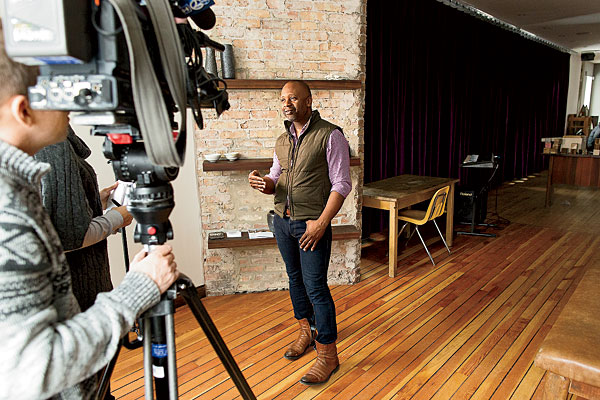
In Chicago and around the country, urban revitalization projects are a dime a dozen—usually undertaken by academics, philanthropists, metropolitan planning agencies, or politicians. What makes Gates’s experiment on South Dorchester an interesting case study isn’t that it is being run by a man with two degrees in urban planning. It’s that the man is using a successful art career to help foot the bills and to plant the flag of high culture in a place that usually sees everything but.
In 2010, Gates decided to start a not-for-profit group, Rebuild, through which he could run community arts projects. In 2012 he hired Sheryl Papier, a former executive with the Frank Lloyd Wright Preservation Trust, to oversee the finer aspects of the program. Papier and 10 part-time staffers now operate a spate of arts programming—artist-led classes, galleries, and artist residency efforts—in seven buildings across three cities: Chicago, Omaha, and St. Louis.
In Omaha, Rebuild partnered with the Bemis Center for Contemporary Arts to renovate a bank that had historic ties to the city’s black residents and reopen it as an arts space. In Pagedale, right outside St. Louis, Rebuild started a weekly poetry workshop that has proved popular enough to be extended indefinitely. “The programming is driven by the residents of the community,” Papier explains.
In Chicago, Rebuild manages Black Cinema House, a screening room and film literacy center that hosts weekly public events on the first floor of 6901 South Dorchester Avenue. Two afternoons a week, its doors open to a group of middle schoolers from the South Shore Fine Arts Academy, a charter school, so they can study filmmaking (the goal of the program: to make a movie about their experiences). To the chagrin of everyone at Rebuild, the neighborhood school Fermi Elementary, which houses the Fine Arts Academy, is on Chicago Public Schools’s latest closing list.
But Rebuild’s most ambitious project is just around the corner, literally: the transformation of a sprawling, boarded-up, trash-strewn public housing complex along Dante Avenue and 70th Street into the city’s first art-centered residential community, the Dorchester Artist Housing Collaborative. “I brought [low-income housing developer] Brinshore to the table, we approached Chicago Housing Authority, and then Rebuild became part of it,” says Gates. “And all that feels like fun dealmaking.”
Construction on the $11 million joint venture between Rebuild and Brinshore is set to start in June. The blighted housing will be converted into a mix of 32 market-rate and affordable two- and three-bedroom apartments for artists and their families. Four buildings will be razed to make room for a new glass-walled arts center that will be the project’s crowning jewel. “This is one of the most exciting ideas: Grand Crossing as a cultural hub,” says Boone, the city’s cultural commissioner. “It’s accessible via public transportation, and the mayor is absolutely interested.”
An influx of artists is often the first step in a downtrodden neighborhood’s path to revitalization. (Witness Wicker Park or New York City’s SoHo.) “Bringing arts and culture into the community is one of the many models for redevelopment in cities that suffer from great vacancies,” says Phil Enquist, a partner with Skidmore, Owings & Merrill.
But Kathleen Cagney, a sociologist and the director of the Population Research Center at the U. of C., points out that it’s hard for a small-scale, somewhat haphazard project to change very much about its neighborhood. (One case in point: Pocket Town, which this magazine wrote about in February.) “It doesn’t mean it’s bad—it can be terrific—but what are the goals for the next decade?” she asks. “Will other people follow him [Gates]? What if he moves on? What happens to the vision?”
While some Grand Crossing inhabitants have never set foot in Gates’s library—and maybe never will—the area feels safer since Gates has anchored himself there. “I look out the window now where I didn’t used to,” says Vaneeta Rollins, 57, who lives a few doors down from the archives. “I have hope that something good will come out of it. If nothing else, he’s fixing up the houses.”
The sheer size of Gates’s real-estate holdings proves his commitment. While he is reluctant to discuss the subject (“I’m going to be abstract about that,” he told Chicago), Cook County records show that he currently owns 12 properties—some in Grand Crossing, some west of there—outright or through limited liability companies that he controls. In addition, his nonprofit (of which he’s the chairman) will soon own a portion of the Dorchester Artist Housing Collaborative complex (at presstime, the city still owned the property). Finally, he’s in the process of closing a deal to buy an old bank at 68th and Stony Island in Grand Crossing. He envisions it as the eventual home of the Ebony/Jet archives, an arts organization incubator, a culinary training program, and a restaurant. (The deal should be finalized in mid-May, he says.)
In all, Gates calculates that he has poured $20 million into the South Side over the past five years—a figure that includes his own spending on not just buildings but also a small army of architects, contractors, artisans, and administrators—plus grants, city and state redevelopment funds, and private donations. “It’s kind of an accumulation,” he says when describing his real-estate ventures. “I don’t think I have it all figured out yet. One day it was like, oh, what can I do with this stuff that is all around me? Maybe if I said yes to this set of books and this set of records, then I could build around it.
“You should always have a project that is just your life work,” he continues. “It should be the thing that carries you through the highs and lows. A kind of constant gardening.”
He leans against the glass of a large window that overlooks the northern stretch of Dorchester Avenue. “I do not want an officious life,” he says, surveying the two-flat he has just purchased across the street. “I do not love publicness. I am not going to stop saying ‘motherfucker.’ But you kind of got to choose. I’m going to just let it play out. Now we can leverage the work to do other things. Now there is no more proving.”



